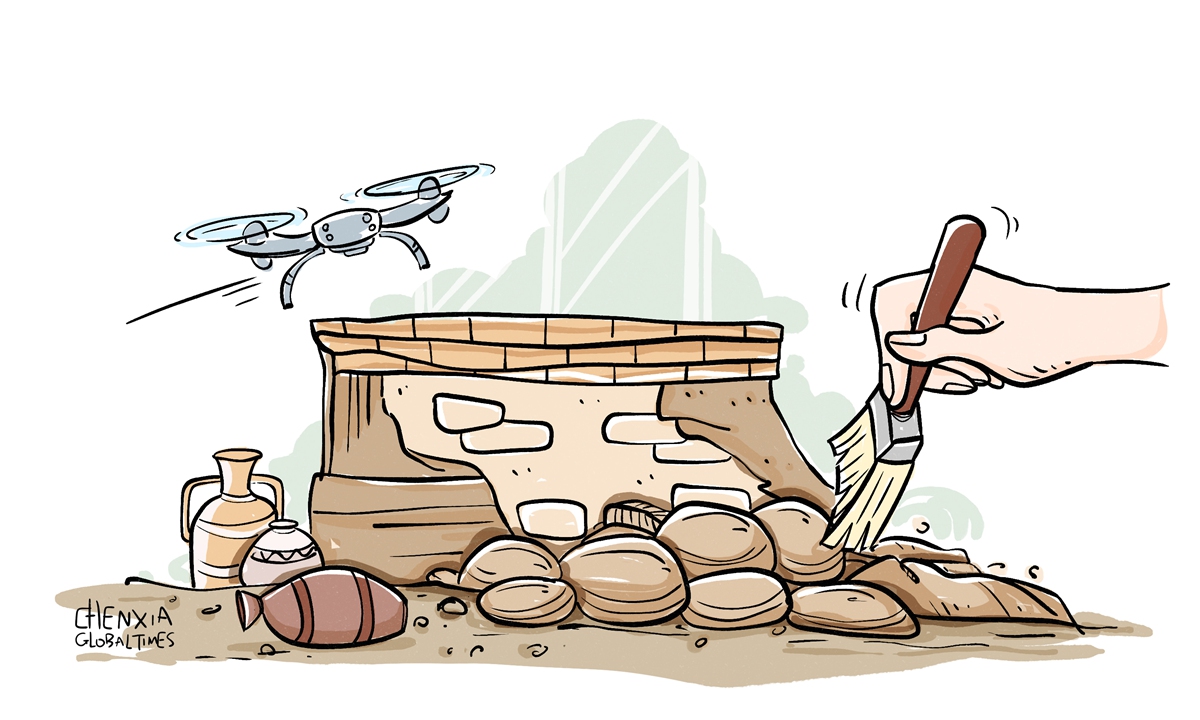
Illustration: Chen Xia/GT
Bathed in the morning sunlight, I put on an official vest and outdoor hat, both emblazoned with "the fourth national cultural relics Census," fastened my surveyor's badge, and gathered an array of equipment to set off on my daily mission.
Joining a local cultural relic survey team, I ventured deep into Southwest China's rural areas, surrounded by mountains and the Yangtze River, and navigated through the rolling hills and dense forests.
Our day was filled with tasks such as taking photos, taking measurements, mapping local areas, and even carrying out aerial drone photography while utilizing real-time Kinematic (RTK) technology for precise positioning. As evening fell, we returned to the office to import, organize, and sort the day's data... This was my daily routine while conducting the fourth national cultural relics census in Southwest China's Chongqing Municipality.
In November 2023, the State Council, China's Cabinet, announced in a notice the launch of the census, which is aimed at establishing a comprehensive national registry and database of immovable cultural relics and building a dynamic management mechanism for these assets.
According to local experts, the census is primarily divided into two sections: One is to complete and supplement information on the cultural relics that were registered during the Third National Cultural Relics Census; the other is to include newly discovered cultural relics.
I was fortunate to accompany a local survey team as they carried out a census at the Huanghua City Archaeological Site Park in Zhongxian county, Chongqing.
Once part of the defenses of the Southern Song Dynasty (960-1279), Huanghua is an isolated city site surrounded by the Yangtze River. When we arrived at the No.1 city gate at the site, what greeted us was not an actual gate but a mound of earth and dilapidated walls as the original gate was long gone. The remaining structure only faintly revealed the arc of an arch, yet the stone walls, built with large boulders, remained sturdy. I couldn't help but marvel at the ingenuity of the craftsmen who transported these massive stones.
A drone took to the skies to capture a bird's eye view of the city wall, and soon the entire image of the gate site appeared on the control screen. The incorporation of drones added a touch of technology to this cultural relic's census.
As I learned to outline the contour of the No.1 city gate from Huang Xing, one of the survey team members, the stone path beneath my feet seemed to transport me back to the Southern Song Dynasty (1127-1279). Alongside a team member, I carefully measured the dimensions of the city gate while Huang skillfully sketched the outline in a notebook and marked the measurements we had taken.
"Although our daily work is almost the same each day, we visit different archaeological sites, which I really enjoy as a history lover. Being here gives me a feeling of traveling through time," Huang, part of the post-1990 generation, said.
Behind the city gate, in the "weapons" area, lay a pile of round, solid stones. At the end of the Southern Song Dynasty, soldiers within the city would hurl these stones from the city walls to repel advancing forces. Standing on this land steeped in history, I felt the weight and vibrancy of the past.
The other site we visited contained a stone tablet made during the Qing Dynasty (1644-1911). This site was discovered by the survey team based on the oral accounts of local villagers.
Indeed, it was a newly discovered cultural relic. Guided by the team, I struggled to make my way through a pathless, overgrown field filled with weeds and reeds, as a flock of sheep grazed quietly beside us.
Lu Xuemei, a member of the survey team, is 57 years old but remained agile in her movements. In contrast, I, a younger person, was left behind and felt quite ashamed. As we walked, she stated that this bit of difficulty was nothing for her.
She recalled the time when she went to investigate an ancient temple, a place with no direct road access, and had to climb up a hill with a slope of nearly 70 degrees. The moss-covered bluestone steps were extremely slippery, but she still managed to climb slowly, taking nearly an hour to finally reach the summit.
"As the saying goes, 'practice makes perfect.' Only through field investigations can one accurately assess and truly understand the current state of cultural relics protection," she said.
Lu has been working for over 30 years and once participated in the third National Cultural Relics Census. She said that she has been deeply impressed by the standardization and technological advancements of the fourth cultural relics survey.
"In the past, data measurement could only rely on tape measures, which were not very efficient or accurate. Nowadays, with technology such as aerial photography and RTK positioning, it is possible to achieve results with centimeter-level precision and double our work efficiency," she said.
Although she expressed her concerns about team building after she retires, I saw how the team was inheriting her experiences. The young cultural relic recorders are continuing to protect historical treasures with passion.
One evening, at the Wanzhou District Planning and Designing Institute in Chongqing, I observed how the staff transformed the day's drone footage into precise planar maps. These maps would eventually form a comprehensive cultural relics distribution map for the district and, by extension, the entire country.
This nationwide census has given me a deep appreciation for the hard work and significance of grassroots workers, filling me with respect for their efforts. It was not only an unforgettable experience but also a cultural baptism.
The author is a reporter with the Global Times. life@globaltimes.com.cn




